

Story
초파리로 밝히는 뇌의 기능
그리고 인공지능
Brain Functions Revealed by Fruit Flies And Artificial Intelligence
전기 · 생체공학부 바이오메디컬공학전공 김안모 교수
Professor Kim Anmo, Major in Biomedical Engineering
- 글 박영임
- 사진 손초원
- Writing Park Yeong-im
- Photograph Son Cho-won
Scroll Down
Fruit flies have a structure similar to that of the human brain, and they are an animal species with DNA that has been studied the most deeply of all, as studies have been accumulated over the past 100 years. Therefore, it is possible to manipulate the genes of fruit flies to reveal the relationships among the nerve cells that the genes generate, behaviors, and brain functions. Professor Kim Anmo of the Major in Biomedical Engineering is establishing the principles of the human brain recognizing things, automatically blocking unnecessary image signals, and selecting only the necessary signals using fruit flies.
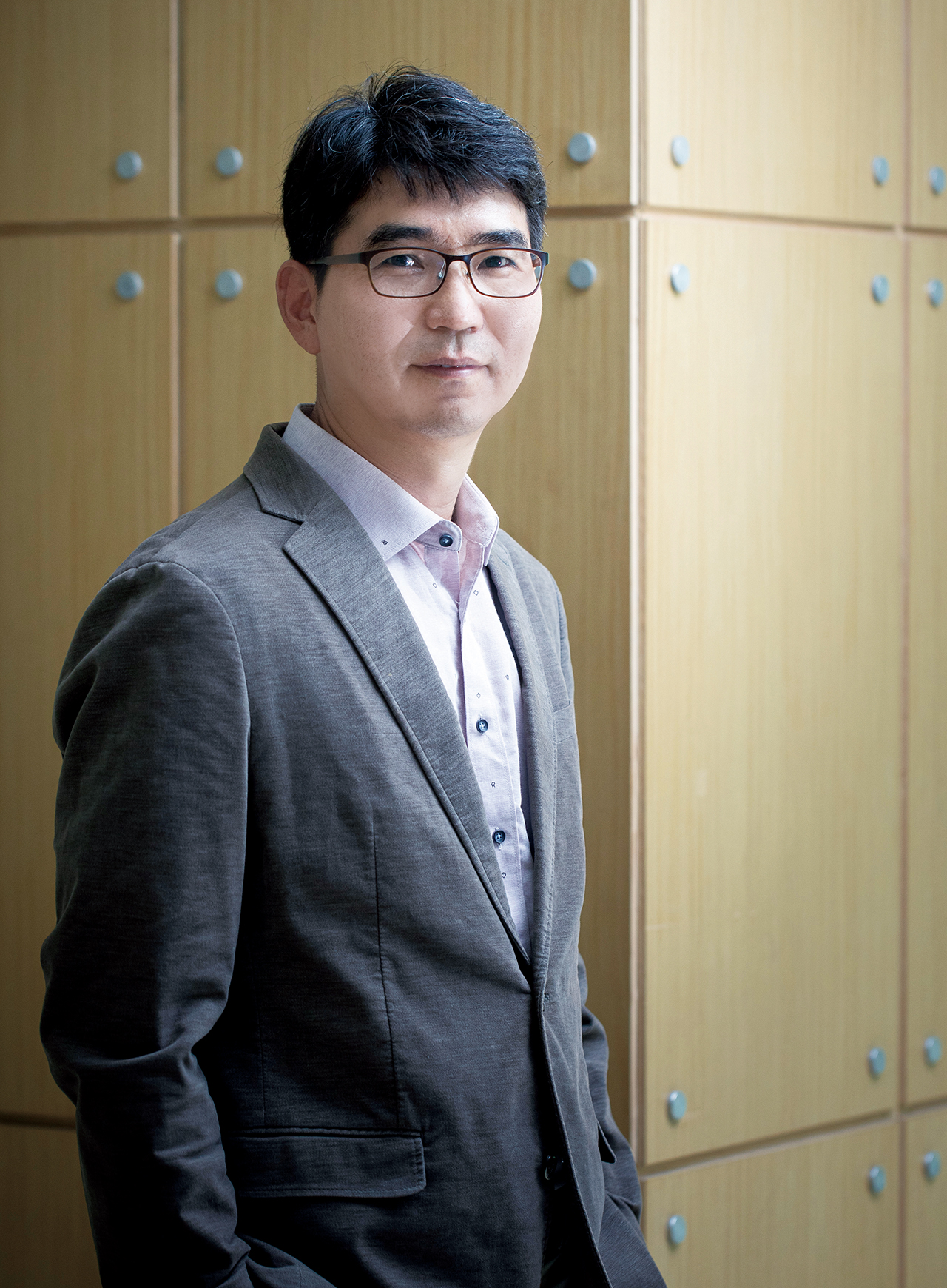
초파리와 인간의 뇌가 닮았다고?
일반인에게는 달갑지 않은 불청객인 초파리. 하지만 연구자들에게는 마우스, 꼬마선충과 더불어 아주 중요한 실험동물이다. 초파리를 처음으로 연구에 이용한 이는 1900년대 초 유전학자인 토머스 헌트 모건(Thomas Hunt Morgan)이었다. 그는 초파리를 통해 유전자와 염색체의 관계를 밝혔고 노벨생리의학상을 받았다. 유전학의 동물이었던 초파리는 2000년대 들어 뇌과학자들에게도 사랑받는 동물이 됐다. 놀랍게도 초파리의 뇌 구조가 인간의 뇌 구조와 유사하기 때문이다.
“모든 생명체의 유전물질은 DNA로 이뤄져 있습니다. 초파리와 사람 모두 그렇죠. 그리고 그 DNA를 이용해 심장, 근육과 같은 몸을 구성하는 원리 역시 동일합니다. 마찬가지로 초파리의 뇌와 인간의 뇌 모두 신경세포라는 유사한 세포로 구성돼 있고, 그 구조 또한 매우 유사합니다. 인간의 뇌보다 작아 실험 통제가 용이한 점도 장점입니다.”
김안모 교수는 초파리를 활용한 뇌과학 연구를 오밀조밀하게 연결된 초파리 내부 기관들이 어떻게 그렇게 복잡한 기능을 수행하는지 밝히는 과정이라고 설명한다. 예를 들어 초파리가 어떻게 방향과 맛을 기억하고 위험을 회피하는지 등을 연구한다는 것이다.
김안모 교수도 시각 패턴인식, 후각 신호처리, 비행 제어, 신경세포 모델링 등 초파리의 신경세포들이 어떻게 뇌 기능에 영향을 미치는지를 연구하고 있다. 초파리를 이용해 뇌의 메커니즘을 규명하고, 그 비밀을 수학적 언어로 기술하고자 한다. 특히 최근 연구는 초파리가 어떻게 세상을 보는지에 초점을 맞추고 있다. 그 결과 중 하나를 지난해 셀(Cell) 자매지인 국제저널 『커런트 바이올로지(Current Biology)』 10월호에 발표했는데, 주요 내용은 뇌가 불필요한 영상신호를 자동으로 차단하고 필요한 신호만 선택한다는 것이다.
“눈동자가 움직일 때마다 우리 눈에는 주변 사물이 재빠르게 움직이는 것처럼 보이지만, 우리 뇌는 이러한 움직임 자극을 인식하지 못합니다. 이는 눈에서 뇌로 신호가 전달되는 과정에서 뇌가 불필요한 영상을 자동으로 차단하기 때문이죠. 만약 흔들린 영상을 시각세포가 일일이 처리한다면 우리는 매초 지진이 일어나는 듯한 세상에서 살게 될 겁니다.”
Fruit flies have similar brains to humans?
To humans, fruit flies are often unwelcome guests. To researchers, however, they are a very important experimental animal, along with mice and C. elegans. The first study of fruit flies was done in the early 1900s by a geneticist, Thomas Hunt Morgan. Through fruit flies, he discovered the relationship between genes and chromosomes, and won the Nobel Prize in Physiology or Medicine. Drosophila, or a fruit fly, which used to be an animal for genetics, has become an animal loved by brain scientists in the 2000s. Surprisingly, the brain structure of a fruit fly is similar to that of a human brain.
“The genetic materials of all living things are made up of DNA. It is the same for fruit flies and humans. The principle of composition of body parts such as heart and muscles using the DNA is the same for both. Likewise, a fruit fly brain and a human brain are both made up of similar cells called neurons, and their structures are also very similar. Another advantage is that it is smaller than a human brain and is easier to control in experiments.”
Professor Kim Anmo explains that the brain science research using fruit flies is a process of revealing how the closely connected internal organs of fruit flies perform such complex functions. It is research of, for example, how fruit flies remember directions and tastes and avoid danger.
Professor Kim Anmo also researches how the nerve cells of a fruit fly affect brain functions, such as visual pattern recognition, olfactory signal processing, flight control, neuron modeling, etc. He intends to investigate the mechanism of a brain using fruit flies and describe its secrets in mathematical language. His recent research, in particular, focuses on how fruit flies view the world. One of the results was published last year in the October issue of the international journal Current Biology, a sister journal of Cell. The main point is that the brain automatically blocks unnecessary image signals and selects only the necessary signals.
“Every time our pupils move, it seems to our eyes that things around us are moving quickly, but our brain does not recognize these movement stimuli. That is because the brain automatically blocks the unnecessary images when the signals are transmitted from the eyes to the brain. If the visual cells processed all moving images, we would be living in a world where earthquakes happen every second.”
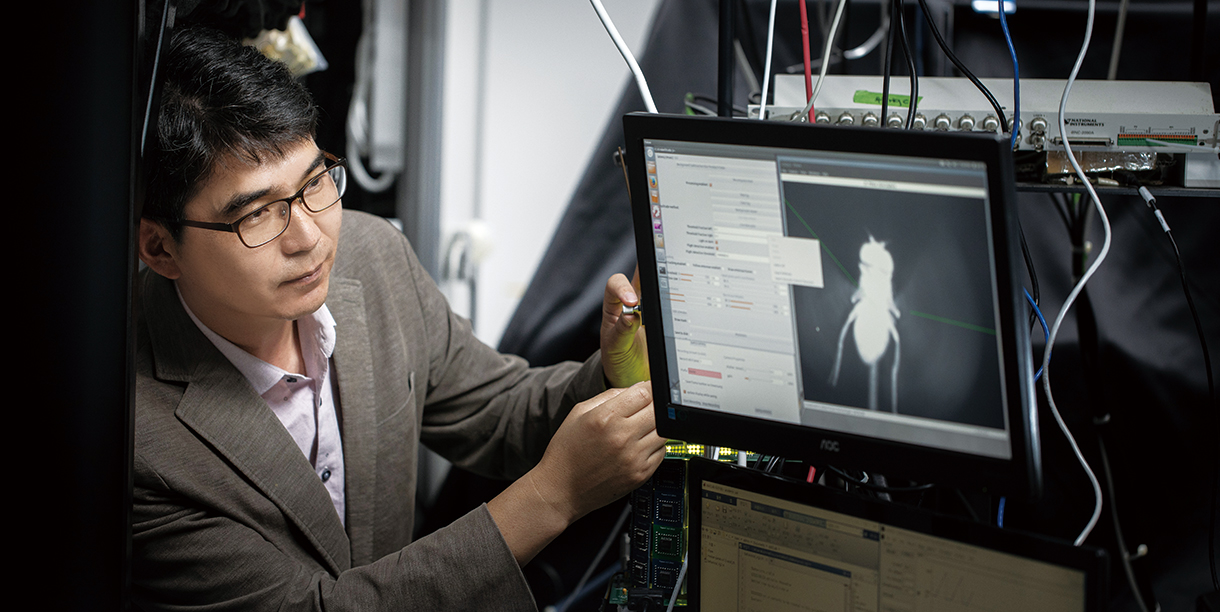
초파리 뇌 연구로 인공지능 기술 개발까지
우리의 뇌가 필요한 영상만 이어 붙여 편집한다는 것은 이미 오래전에 알려진 사실이다. 하지만 이를 실제 인간의 뇌로 실험할 길은 막막하다. 김안모 교수의 연구는 초파리 실험을 통해 인간만 흔들린 영상을 차단하는 것이 아니며, 그러한 현상이 신경세포 단위에서 어떻게 일어나는지를 규명할 수 있는 실마리를 제공했다는 점에서 의미가 크다.
“실험을 통해 비행하는 초파리의 뇌에서도 우리 뇌와 같이 흔들린 영상을 자동으로 차단하는 현상이 나타난다는 것을 밝혔습니다. 초파리는 비행 중 초당 2~3번씩 갑자기 방향을 전환하는 비행 패턴을 보이는데 이때 우리 눈과 같이 흔들리는 움직임이 초파리 눈에 감지됩니다. 하지만 스스로 회전하는 경우 흔들림 신호를 자동으로 차단하는 것으로 나타났어요. 연구가 진행될수록 초파리 시각과 인간 시각이 유사하다는 것이 밝혀지고 있습니다.”
흐린 영상이 차단되는지 확인하기 위해 김안모 교수 연구팀은 머리카락 굵기 백분의 일 크기의 전극을 초파리의 시각 신경세포에 부착하고 신호를 측정했다. 그 결과, 초파리가 비행 중 급회전할 때마다 움직임 신호가 자동적으로 차단되는 것을 확인했다. 앞으로 김안모 교수는 후발 연구를 통해 뇌가 불필요한 흔들린 영상을 차단하는 원리도 규명할 계획이다.
불필요한 흔들린 영상을 영리하게 차단할 수 있는 원리를 밝히면 인공지능 로봇에 부착된 카메라의 영상처리에도 활용할 수 있다. 로봇이 움직일 때마다 진동이 발생하는데 이런 진동은 카메라 영상에 영향을 준다. 김안모 교수는 초파리 시각 신경세포에 관한 연구 결과를 바탕으로 흔들리는 카메라 영상을 선택적으로 처리하는 알고리즘을 개발해 자율주행 드론에 적용할 계획이다. 이는 추후 자율 AI 로봇의 센서 신호 처리에도 활용이 가능하다. 이렇게 초파리의 뇌를 연구하는 일은 인간 뇌의 작동원리를 밝힐 뿐 아니라, 뇌 신경망을 모사한 인공지능의 기능을 발전시키는 데도 기여할 수 있다.
Artificial intelligence technology development with fruit fly brain research
It has been known for a long time that our brain only selects and edits the necessary images. However, it is still difficult to test it with a real human brain. Professor Kim Anmo’s research is significant in that, through his fruit fly experiment, he found out that it is not only humans that block moving images, and provided clues to how this happens at the nerve-cell level.
“Through experiments, we revealed that the phenomenon of blocking moving images happens in a fruit fly’s brain, just as in human brains. Fruit flies show a flight pattern that changes directions every two to three seconds. At this time, as in human eyes, the same shaking movements are also detected by the eyes of the fruit flies. However, when they turn on their own, it has been shown that they automatically block the movement signals. As research progresses, it is becoming clear that the vision of fruit flies is similar to human vision.”
To check if blurry images are blocked, Professor Kim’s team attached electrodes that are one hundredth the thickness of a human hair strand to the visual nerve cell of a fruit fly and measured the signals. As a result, it was confirmed that the movement signals were automatically blocked when the fruit fly makes a sharp turn during its flight. In the future, Professor Kim plans to uncover the principle that the brain blocks unnecessary shaking images.
Applying the principle that cleverly blocks unnecessary images, it can be used in the image-processing of cameras attached to AI robots. Vibrations occur whenever robots move, and these vibrations thus affect the resulting images. Based on the results of the research on the fruit fly nerve cells, Professor Kim Anmo plans to develop an algorithm that selectively processes the shaky camera images to apply to autonomous drones. This can also be applied to the sensor signal processing of autonomous AI robots in the future. Studying the brains of fruit flies not only can reveal the working principle of the human brain, but also contribute to the development of the functions of artificial intelligence that imitate the brain’s neural network.
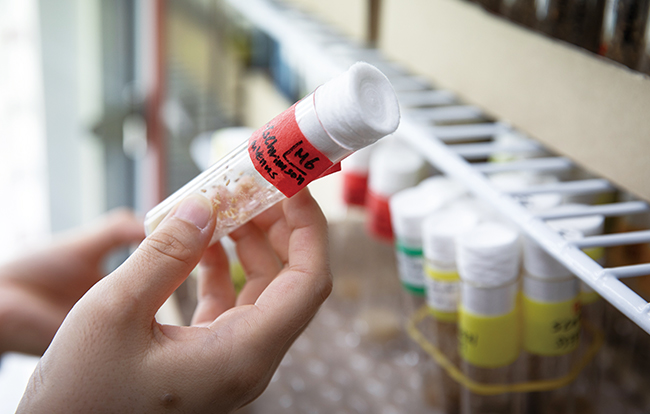
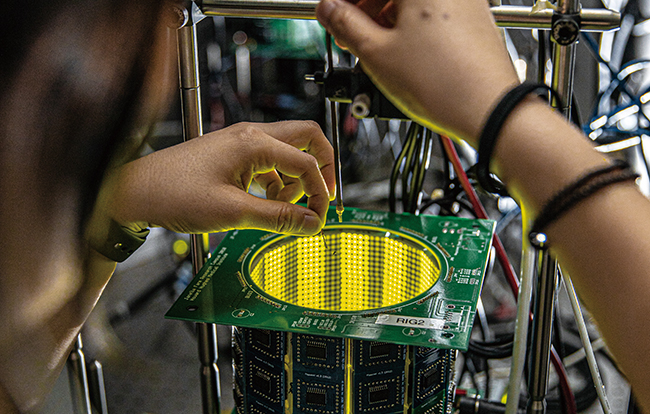
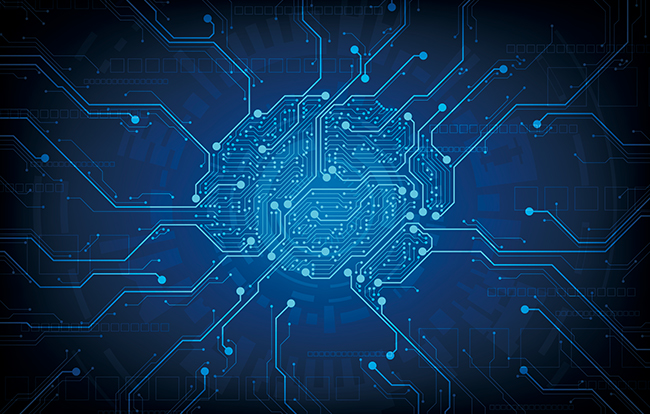
초파리를 이용해 인간 뇌의 메커니즘을 규명하는 연구는 새로운 인공지능 알고리즘 개발에도 큰 영향을 미칠 것이다
Researches to investigate the mechanism of the human brain through fruit flies will have a great impact on the development of a new artificial intelligence algorithm.
뇌의 신비를 풀어나가는 실마리
“현재 한국연구재단의 ‘미래뇌융합기술개발사업’이라는 과제에 참여하고 있습니다. 생명체 지능의 원리를 파악해 새로운 인공지능 알고리즘을 개발하는 것이 목표죠. 인공지능 연구는 뇌과학에서 영감을 받아 시작됐지만, 현재는 뇌 기능의 아주 작은 일부만 모방하는 수준입니다. 초파리와 같은 작은 신경회로로 다양한 뇌 기능을 수행하는 것을 연구하면 인공지능 기술의 한계를 보완하는 데 도움이 될 것입니다.”
인공지능은 이미 우리의 삶에 속속들이 자리 잡아 놀라운 편의성을 선사하고 있다. 하지만 그 경이로운 능력에도 불구하고 아직 인간의 뇌에 미치지 못한다는 평을 받고 있다. 예를 들면, 현재의 인공지능 기술은 하나의 임무에만 특화돼 있어 다른 기능을 학습하면 기존에 학습된 기능은 무용지물이 된다. 또한 인간은 여러 감각을 이용해 사물을 인식하지만, 인공지능은 서로 다른 감각을 동시에 처리하는 데 어려움이 있다. 김안모 교수 연구팀은 실제 초파리의 시각과 온도 신호가 어떻게 행동에 영향을 미치는지 연구하는 중인데, 이를 통해 인공지능의 다감각 처리 시스템을 개발할 예정이다. 김안모 교수는 뇌과학의 연구들이 인공지능을 한층 진일보시키는 데 큰 역할을 할 수 있다고 말한다.
“2000년대 들어 미국을 중심으로 신경과학 연구에 집중적인 투자가 이루어져 뇌의 비밀이 놀라운 속도로 밝혀지고 있습니다. 초파리의 경우 지난 20년 동안 시각, 청각, 후각, 비행 제어, 공간기억까지 이전에 불가능하다고 생각했던 연구 결과들이 발표되고 있어요. 저도 이러한 연구자들과 함께 초파리의 시각을 중심으로 연구를 진행하고 있습니다. 아마도 10년 후면 정말 초파리 뇌의 모든 기능이 밝혀지지 않을까 생각합니다. 그러한 결과들을 통합해 초파리처럼 날고, 판단하고, 학습하고, 이동하는 자율로봇 알고리즘을 개발하는 것이 저의 큰 꿈이 되었습니다.”
소금 알갱이만큼 작은 초파리의 뇌를 통해 속속 밝혀지는 뇌의 신비. 이는 인간을 이해하는 데 큰 영향을 미칠 뿐 아니라 인공지능 기술 발전의 물꼬를 터주는 좋은 밑거름이 될 것이다.
A clue to unraveling the mysteries of the human brain
“We are currently participating in the Future Brain Convergence Technology Development Project of the National Research Foundation of Korea. The goal is to develop a new artificial intelligence algorithm by understanding the principles of intelligence of living things. Artificial intelligence research began with the inspiration from brain science, but it now only imitates a small fraction of brain functions. Studying the performance of various brain functions with the tiny nerve cells of fruit flies will help address the limitations of artificial intelligence technology.”
Artificial intelligence is already instilled in our daily lives, providing incredible convenience. However, despite its surprising abilities, it has not reached the level of the human brain. For example, the current artificial intelligence technology is specialized in one task only; and learning another skill will make the previously learned function useless. In addition, while humans use multiple senses to recognize objects, artificial intelligence has difficulty processing different senses at the same time. Professor Kim Anmo’s team is working on the research on how actual fruit fly visual and temperature signals affect their behavior. Through this, they plan to develop an artificial intelligence multisensory processing system. Professor Kim Anmo says that the brain science researches can play a big role in advancing artificial intelligence.
“Since the 2000s, investments have been made by various countries in the field of neuroscience, starting with the United States, and the secrets of the brain are being revealed at an alarming rate. Based on the researches on fruit flies, results that were previously thought impossible are being published over the past 20 years, including insights into their vision, hearing, smell, flight control, and spatial memory. Just as these researchers have done, I am also conducting researches focusing on the vision of fruit flies. I believe that perhaps in 10 years, all the functions of the fruit fly brain will be revealed. My dream is to develop an autonomous robot algorithm that flies, judges, learns and moves like fruit flies, by integrating those results.”
The mysteries of the brain are being revealed seriatim through the brain of a tiny fruit fly. This will not only have a great impact on understanding humans, but also serve as a good foundation for artificial intelligence technology development.
